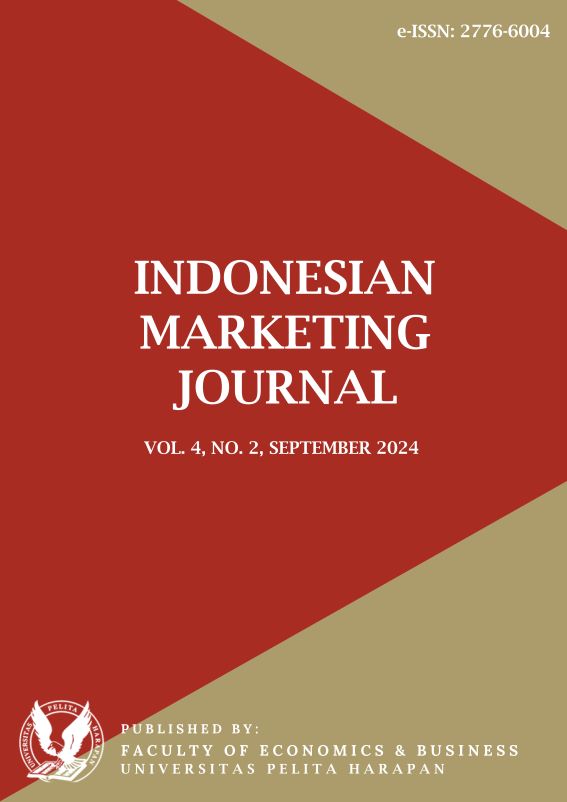Creating and Capturing Value: Strategic Corporate Social Responsibility, Resource-Based Theory, and Sustainable Competitive Advantage Abigail Mcwilliams and Donald S. Siegel (Critical Review) [Menciptakan dan Menangkap Nilai: Tanggung Jawab Sosial Perusahaan yang Strategis, Teori Berbasis Sumber Daya, dan Keunggulan Kompetitif yang Berkelanjutan Abigail Mcwilliams dan Donald S. Siegel (Tinjauan Kritis)]
DOI:
https://doi.org/10.19166/imj.v4i2.9718Λέξεις-κλειδιά:
CSR, Competitive Advantage , Social Value, Hedonic Pricing, Contingent Valuation, Corporate Reputation, [CSR, Teori Berbasis Sumber Daya, Keunggulan Kompetitif, Nilai Sosial, Harga Hedonis, Valuasi Kontingensi, Reputasi PerusahaanΠερίληψη
This article explores the strategic role of Corporate Social Responsibility (CSR) in building sustainable competitive advantage through the lens of Resource-Based Theory (RBT). In the era of globalization and increasing business competition, CSR is not only viewed as a social obligation but also as a business strategy that generates added value (social value) for companies. Referencing studies by McWilliams & Siegel, as well as Bagnoli & Watts, this article highlights how CSR can enhance corporate reputation, attract investors, and strengthen relationships with consumers and society. By integrating RBT with Hedonic Pricing and Contingent Valuation models, CSR is shown to influence consumer perceptions and support product differentiation strategies. Therefore, CSR serves as a crucial element in a company’s strategic framework to achieve profit maximization and long-term sustainability.
Abstrak Bahasa Indonesia: Artikel ini membahas peran strategis Corporate Social Responsibility (CSR) dalam membentuk keunggulan kompetitif berkelanjutan melalui pendekatan Resource-Based Theory (RBT). Dalam konteks globalisasi dan persaingan bisnis yang semakin ketat, CSR tidak hanya dipandang sebagai bentuk tanggung jawab sosial, tetapi juga sebagai strategi bisnis yang dapat menciptakan nilai tambah (social value) bagi perusahaan. Penelitian yang dirujuk dalam artikel ini, termasuk dari McWilliams & Siegel, serta Bagnoli & Watts, menekankan bagaimana CSR dapat meningkatkan reputasi perusahaan, menarik investor, serta memperkuat hubungan dengan konsumen dan masyarakat. Melalui integrasi RBT dengan model hedonic pricing dan contingent valuation, CSR dinilai mampu memengaruhi persepsi konsumen dan mendukung strategi diferensiasi produk. Dengan demikian, CSR menjadi bagian penting dalam strategi perusahaan untuk mencapai profit maksimal dan keberlanjutan jangka panjang.
Αναφορές
Ardiansyah, A., Sari, W. P., & Supriadi, F. (2024). Eksplorasi peran tanggung jawab sosial perusahaan (CSR) dalam strategi pemasaran dan penciptaan nilai: Sebuah tinjauan literatur. Jurnal Produktivitas: Jurnal Fakultas Ekonomi Universitas Muhammadiyah Pontianak, 11(1), 256–539. http://dx.doi.org/10.29406/jpr.v11i1.6886
Bagnoli, M., & Watts, S. G (2003). Selling to socially responsible consumers: Competition and the private provision of public goods. Journal of Economics and Management Strategy, 12(3), 419–445. https://doi.org/10.1111/j.1430-9134.2003.00419.x
Baron, D. P. (2001). Private politics, corporate social responsibility and integrated strategy. Journal of Economics and Management Strategy, 10(1), 7–45. https://doi.org/10.1111/j.1430-9134.2001.00007.x
Cheraghalizadeh, R., Olya, H., & Tumer, M. (2021). The effects of external and internal factors on competitive advantage moderation of market dynamism and mediation of customer relationship building. Sustainability, 13(7), 1–15. https://doi.org/10.3390/su13074066
Donnet, M. L., Weatherspoon, D. D., & Hoehn, J. P. (2007). What adds value in specialty coffee? Managerial implications from hedonic price analysis of Central and South American e-auctions. International Food and Agribusiness Management Review, 10(3), 1–18. https://doi.org/10.22004/ag.econ.8162
Fombrun, C., & Shanley, M. (1990). What’s in a name? Reputation building and corporate strategy. Academy of Management Journal, 33(2), 233–258. http://dx.doi.org/10.2307/256324
Gujarati, D. N., & Porter, D. C. (2009). Essentials of econometrics. McGrow Hill.
Klein, B., & Leffler, K. B. (1981). The role of market forces in assuring contractual performance. Journal of Political Economy, 89(4), 615–641.
Manasakis, C., Mitrokostas, E., & Petrakis, E. (2007). Corporate social responsibility in oligopoly. Working Paper, 7(7), 1–22.
McWilliams, A., & Siegel, D. (2001). Corporate social responsibility: A theory of the firm perspective. Academy of Management Review, 26(1), 117–127. http://dx.doi.org/10.5465/AMR.2001.4011987
McWilliams, A., & Siegel, D. S. (2011). Creating and capturing value: Strategic corporate social responsibility, resource-based theory, and subtainable competitive advantage, Journal of Management, 37(5), 1480–1495. https://doi.org/10.1177/0149206310385696
Nyborg, K., & Brekke, K. A. (2004). Moral hazard and moral motivation: Corporate social responsibility as labor market screening. University of Oslo Economics Working Paper, 25(1), 1–28. https://dx.doi.org/10.2139/ssrn.645741
Paul, J., & Criado, A. R. (2020). The art of writing literature review: What do we know and what do we need to know? International Business Review, 29(4), 1–24. https://doi.org/10.1016/j.ibusrev.2020.101717
Rahmawati, A. (2011). PT. Paragon Technology and innovation (Wardah Cosmetics). Jakarta, Surabaya: Universitas Islam Nusantara.
Rowe, F. (2022). Being critical is good: A review of critical literature reviews in information systems. Information and Organization, 32(2), 380–393. https://doi.org/10.1080/0960085X.2018.1471789
Russo, M., & Fouts, P. (1997). A resource-based perspective on corporate environmental performance and profitability. Academy of Management Journal, 40(3), 534–559. https://doi.org/10.2307/257052
Λήψεις
Δημοσιευμένα
Τεύχος
Ενότητα
Άδεια
Πνευματική ιδιοκτησία (c) 2025 Dewi Wuisan

Αυτή η εργασία είναι αδειοδοτημένη υπό το Creative Commons Attribution-ShareAlike 4.0 International License.
Authors who publish with this journal agree to the following terms:
1) Authors retain copyright and grant the journal right of first publication with the work simultaneously licensed under a Creative Commons Attribution License (CC-BY-SA 4.0) that allows others to share the work with an acknowledgement of the work's authorship and initial publication in this journal.
2) Authors are able to enter into separate, additional contractual arrangements for the non-exclusive distribution of the journal's published version of the work (e.g., post it to an institutional repository or publish it in a book), with an acknowledgement of its initial publication in this journal.
3) Authors are permitted and encouraged to post their work online (e.g., in institutional repositories or on their website). The final published PDF should be used and bibliographic details that credit the publication in this journal should be included.


